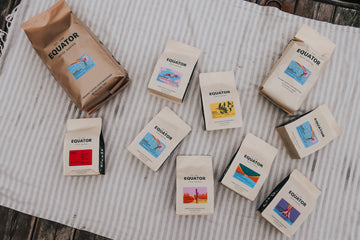
There is a growing movement for understanding where your food comes from. From the meat on your dinner table to the almond milk in your fridge, understanding how your food gets from the land to your table empowers you to make purchasing decisions that are inline with your personal values. The same cannot be more true with coffee. In this series, we will cover coffee from crop to cup.
What makes a blend?
Most coffee you find on the shelves of your favourite cafés or boutiques are blends. This means that the coffee in the bag is a blend of beans from different regions. As we explored in a previous blog, the origin of the coffee has a huge impact on the way it tastes and mixing different coffees together builds a depth of flavour.
You may remember that when purchasing coffee, Equator selects coffee that meets our desired flavour profiles. This usually requires a blend of different coffees to get it just right and results in a complex, layered, and delicious cup of coffee. For instance, coffee from Peru tends to be very sweet. This sweetness would be balanced with complementary flavours from other origins.
What is Single Origin?
Single Origins by contrast, are one coffee variety from a single farm or cooperative. Tasting a coffee on its own in this way is the best way to taste a coffee to determine its flavour profile and to better understand what that region’s terroir has to offer.
The higher the elevation, the brighter the coffee tends to be. High elevation countries in East Africa create a smaller, denser coffee bean, which when roasted lightly, you will find flavours like Ethiopian bergamot or black tea. While coffees from Central America are known for their versatility, Mexico and Guatemala produce robust coffees that boast chocolatey notes. Because of this, different origins lend themselves better to different roasts.
In order to stand up on its own, Single Origin coffees are usually higher-end coffee and come with a higher price tag. Because it’s only one type of coffee, many Single Origins are one-dimensional and won’t be sold on their own. So when a coffee is special enough to be roasted and brewed on its own, it’s a pretty special coffee.
Which is better?
To say that Single Origins are better than blends is misguided. If you’re looking for something familiar, dependably delicious, and balanced, you will always find that with our blends. On the other hand, if you want to learn about coffee, the different coffee growing regions, and experiment with different flavours and acid levels, then you will love the unpredictability of Single Origin coffees. Coffee is a choose-your-own-adventure book.
How to brew blends vs. Single Origins.
When trying any new coffee, we recommend starting with a v60 pour over or aeropress. These low-tech methods are gentle and allow each grain of coffee to bloom and maximize the more subtle notes of the coffee. Single Origins are typically roasted lightly in order to preserve as much of the coffee’s fruitiness as possible. We recommend brewing lighter roasts at a hotter temperature (206°F or right off the boil) in order to break down the denser cells and extract all the flavour. For dosage and time, see our Brew Guide.